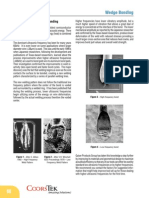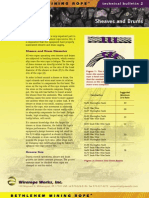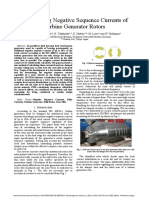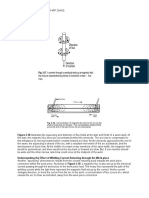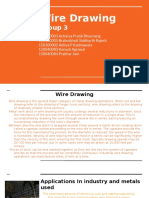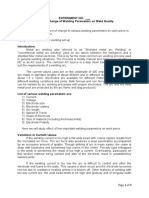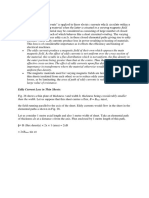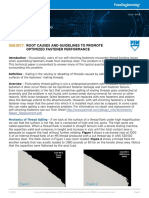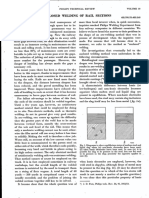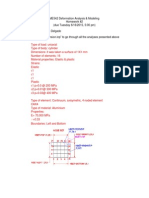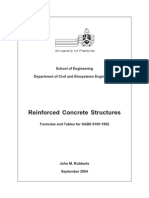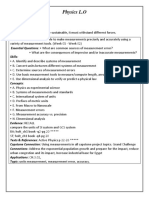Residual Stresses. Residual Stresses Are Created in A Wire Wire Vibrations. Since Wires Are Typically Unsupported
Residual Stresses. Residual Stresses Are Created in A Wire Wire Vibrations. Since Wires Are Typically Unsupported
Uploaded by
Diego PinoCopyright:
Available Formats
Residual Stresses. Residual Stresses Are Created in A Wire Wire Vibrations. Since Wires Are Typically Unsupported
Residual Stresses. Residual Stresses Are Created in A Wire Wire Vibrations. Since Wires Are Typically Unsupported
Uploaded by
Diego PinoOriginal Title
Copyright
Available Formats
Share this document
Did you find this document useful?
Is this content inappropriate?
Copyright:
Available Formats
Residual Stresses. Residual Stresses Are Created in A Wire Wire Vibrations. Since Wires Are Typically Unsupported
Residual Stresses. Residual Stresses Are Created in A Wire Wire Vibrations. Since Wires Are Typically Unsupported
Uploaded by
Diego PinoCopyright:
Available Formats
TECHNICAL PAPERS
Fig. 7. Longitudinal metallographic section of a copper Fig. 8. Longitudinal metallographic section of a copper
wire that was plated with nickel to preserve the wire that has been plated with nickel to preserve the
subsurface. A line of cracks is revealed below the subsurface. A delamination fine is captured here lifting
surface that was created via delamination wear. The off the wire surface.
material between the wire surface and the crack-line
experiences greater deformation than the rest of the
wire.
at the wire-die interface, albeit the surface contact area and ing the die must be at an angle to the die axis. Second, resid-
sliding distance are low. On the other hand, low-angled ual stresses can cause the wire to move off the die axis in favor
dies reverse this situation by lowering die pressure and of its preferred cast. Consequently, attempting to align dies as
increasing the contact area and sliding distance. An opti- if the wire were a “string” that could be strung along the die
mal total included die angle of 16 to 20 degrees balances axis may not result in the optimal die alignment.
these competing influences. Wire vibrations. Since wires are typically unsupported
Residual stresses. Residual stresses are created in a wire between the capstan and the die, they may undergo severe
during typical drawing processes due to several factors. If the vibrations as a result of stick-slip oscillations, impinging
residual stresses are created fairly uniformly around the cir- lubricant flow or machinery oscillations. Except for fine wire
cumference of the wire, then their influence on fines is negli- drawing, vibrations seem innocuous because the wire usually
gible. One source of uniform residual stress is uniform wire impacts nothing other than the capstan and the die. However,
surface heating during drawing and subsequent cooling prior the influence of wire vibrations at the die entrance is, in fact,
to the next die pass. On the other hand, the residual stresses substantial. Wire vibrations cause oscillations in the wire near
created within a wire are often highly non-uniform, which the die surface, and may create three problems, namely:
does accelerate fines generation. Baker and Pops have 1) The hydrodynamic lubricant film is disturbed. As noted
explained in detail how non-uniform internal stresses may before, in high-speed drawing with liquid lubricants, it is best
develop13. These stresses cause the wire to shift off its die axis to have the thickest and most comprehensive hydrodynamic
and result in asymmetric drawing. A realistic cross-section of lubricant film possible. However, this lubricant film is fragile,
such a wire and die is illustrated in Fig. 13. Asymmetric draw- and is most stable only with constant fluid flow. Vibrations of
ing causes the wire to experience extreme pressures on one the wire disturb the hydrodynamic process and do not give the
point in its circumference which are higher than the pressure film enough stability to develop its full potential.
expected by the die design. In Fig. 13 the top of the wire has 2) Die areas are subject to fatigue. Wire vibrations acceler-
a longer contact length with the die, which would therefore ate die wear by placing die areas under cyclic stresses, as illus-
increase fines generation via this increased sliding contact. trated in Fig. 14. Vibrations alter the location of worn areas in
When the reduction zone is too small, the top of the wire the reduction zone and create a wider wear ring. Basic fatigue
might even hit the bell, again creating substantially more theory dictates that materials under cyclic stresses will fail at
fines. On the other hand, the bottom of the wire can cause much lower applied stresses than materials under static stress.
greater die pressures, which would also lead to increased 3) Higher die pressures are generated. As the wire oscillates
fines. with respect to the die, it increases the maximum die pressure
It has been mentioned already that gross mis-alignment and consequently increases die wear, as seen in Fig. 14.
between the wire and the die can cause high fines generation. Sometimes wire surfaces show evidence of transverse
Unfortunately, a perfectly aligned die is most often unachiev- scratches that result from vibrations of the wire at the die exit,
able for two reasons. First, in cone-type machines the die as shown in Fig. 15. Wire vibrations at the die exit may not
changes the wire’s direction slightly to allow for proper con- have a significant influence on die wear or the lubricant film,
tact with the capstans. Consequently, the wire entering or exit- but marks on the wire surface created at the die exit will accel-
72 | WIRE JOURNAL INTERNATIONAL
You might also like
- Coil WindingDocument17 pagesCoil WindingSourav Das0% (1)
- Wire Rope LubricationDocument16 pagesWire Rope LubricationAnonymous alQXB11EgQNo ratings yet
- 11.1 Engineering Mechanics 01 SolutionsDocument6 pages11.1 Engineering Mechanics 01 SolutionsJhune Sobrepeña50% (4)
- Theory of Wire DrawingDocument27 pagesTheory of Wire Drawinggamini ranaweera80% (5)
- Wire Rope Forensics Letter PDFDocument50 pagesWire Rope Forensics Letter PDFAshley DeanNo ratings yet
- CoorsTek SmWedgeDocument60 pagesCoorsTek SmWedgeRonnie MagsinoNo ratings yet
- Acceleration of Fines Generation: OCTOBER 2009 - 71Document1 pageAcceleration of Fines Generation: OCTOBER 2009 - 71Diego PinoNo ratings yet
- Levine, Wire Bonding ExplainedDocument4 pagesLevine, Wire Bonding Explainedshogun1No ratings yet
- The Multi Layer Coil: Winding Machine InductanceDocument3 pagesThe Multi Layer Coil: Winding Machine InductanceReymark de GuzmanNo ratings yet
- Get Grounded: Protecting Electrical Devices From Lightning TransientsDocument13 pagesGet Grounded: Protecting Electrical Devices From Lightning Transientsdigit133No ratings yet
- Arc Wandering Arc Blow Back Step WeldingDocument4 pagesArc Wandering Arc Blow Back Step WeldingJoseph PeterNo ratings yet
- Crane Drums and CablesDocument4 pagesCrane Drums and Cablesjoe_frangieh100% (1)
- How To Prevent Arc BlowDocument12 pagesHow To Prevent Arc BlowFelix GomintongNo ratings yet
- Mig Wire Burn Back DetailsDocument23 pagesMig Wire Burn Back DetailsSridhar CnNo ratings yet
- Defects Lack of Side Wall FusionDocument4 pagesDefects Lack of Side Wall Fusionguru_terexNo ratings yet
- Strain Ageing PDFDocument74 pagesStrain Ageing PDFKhalid AkbaryNo ratings yet
- An Easy To Build Shielded Magnetic Loop ProbeDocument4 pagesAn Easy To Build Shielded Magnetic Loop Probe4hgtrb0xNo ratings yet
- Minimizing Weld Defects in SAWDocument3 pagesMinimizing Weld Defects in SAWNalla Gane100% (1)
- Determining Negative Sequence Currents of Turbine Generator RotorsDocument6 pagesDetermining Negative Sequence Currents of Turbine Generator RotorsLeticia AlmeidaNo ratings yet
- Busbar TightnessDocument11 pagesBusbar Tightnesssanjeev267No ratings yet
- Fig. 4. Image of A Fine-Grained Polycrystalline Diamond Die Surface, Displaying Sharp Grain Boundaries. Photo Courtesy of Fort Wayne Wire DieDocument1 pageFig. 4. Image of A Fine-Grained Polycrystalline Diamond Die Surface, Displaying Sharp Grain Boundaries. Photo Courtesy of Fort Wayne Wire DieDiego PinoNo ratings yet
- How The Weather Affects ConductorsDocument2 pagesHow The Weather Affects ConductorsBinda MridulabalakrishnanNo ratings yet
- Notes-Api Exams-Prathap DhasDocument7 pagesNotes-Api Exams-Prathap DhasAnonymous 4e7GNjzGWNo ratings yet
- LevelerDocument8 pagesLevelertheravikantNo ratings yet
- InterlaminarlossesDocument6 pagesInterlaminarlossesSahas ShahNo ratings yet
- Crane Wire Rope Damage and Inspection MethodsDocument11 pagesCrane Wire Rope Damage and Inspection MethodsScott BeattyNo ratings yet
- Q.1 Which Welding Technique You Would Adopt To Weld The Vertical Seams of TwoDocument38 pagesQ.1 Which Welding Technique You Would Adopt To Weld The Vertical Seams of Twoquiron2010No ratings yet
- 2AdesigncomparisonofCastellatedbeambetweenIS 800 1984andIS 800 2007 - Asad - SeffronyDocument6 pages2AdesigncomparisonofCastellatedbeambetweenIS 800 1984andIS 800 2007 - Asad - SeffronySamved PatelNo ratings yet
- Submerged Arc WeldingDocument42 pagesSubmerged Arc WeldingMário SilvaNo ratings yet
- Electrical Insulated TPI WL 43-1189 2 de enDocument14 pagesElectrical Insulated TPI WL 43-1189 2 de enRodrigo Jechéla BarriosNo ratings yet
- Transformer-Causes and FailuresDocument3 pagesTransformer-Causes and FailuresNer AlenoNo ratings yet
- MCL 231 Term PaperDocument6 pagesMCL 231 Term Paperaman rajNo ratings yet
- Mig Welding - Setting InductanceDocument7 pagesMig Welding - Setting InductanceahmedNo ratings yet
- Transformer Short Circuit Testing and Its Impact On Tap Changer FinalDocument6 pagesTransformer Short Circuit Testing and Its Impact On Tap Changer Finalsatheesh BabuNo ratings yet
- Impact of Slot Discharges and Vibration Sparking On Stator Winding Life in Large GeneratorsDocument8 pagesImpact of Slot Discharges and Vibration Sparking On Stator Winding Life in Large GeneratorsShanjiNo ratings yet
- Wire Drawing: Group 3Document6 pagesWire Drawing: Group 3Pratik AcharyaNo ratings yet
- How and Why Varistor Failure Occurs Including The Effect of Multipulse Surges - in Compliance MagazineDocument15 pagesHow and Why Varistor Failure Occurs Including The Effect of Multipulse Surges - in Compliance MagazinerisoltotuttoNo ratings yet
- Testing On Generator StatorDocument36 pagesTesting On Generator StatorSajid Akhter100% (2)
- Experiment No.: - Effect of Change of Welding Parameters On Weld Quality AimDocument3 pagesExperiment No.: - Effect of Change of Welding Parameters On Weld Quality AimVandan GundaleNo ratings yet
- Arc BlowDocument8 pagesArc BlowAnonymous 4e7GNjzGWNo ratings yet
- Twisting Towers To Couple Processes in A Non-Linear WayDocument8 pagesTwisting Towers To Couple Processes in A Non-Linear WayJJNo ratings yet
- Manufacturing Flat Coil Configurations For Stepper MotorsDocument6 pagesManufacturing Flat Coil Configurations For Stepper MotorsJaswant Kumar ChaudharyNo ratings yet
- BRIDON BAC TechnicalDocument25 pagesBRIDON BAC TechnicalMohamed SidateNo ratings yet
- Complete Overview of Lightning Arrester 3Document9 pagesComplete Overview of Lightning Arrester 3VENKATESAN RNo ratings yet
- Lecture 7Document11 pagesLecture 7yoziscijuniorNo ratings yet
- Sheet Eddy LossesDocument11 pagesSheet Eddy LossesRavi KumarNo ratings yet
- Tech Sheet: Root Causes and Guidelines To Promote Optimized Fastener PerformanceDocument9 pagesTech Sheet: Root Causes and Guidelines To Promote Optimized Fastener PerformanceFarzadNo ratings yet
- Commentary On Highly Restrained Welded ConnectionsDocument13 pagesCommentary On Highly Restrained Welded ConnectionstrabajosicNo ratings yet
- Wireline Advisory WilcoDocument5 pagesWireline Advisory WilcoWilliam EvansNo ratings yet
- Enclosed Arc WeldingDocument7 pagesEnclosed Arc WeldingMakrand ShindeNo ratings yet
- Optimizing Efficiency in HF Tube Welding ProcessDocument4 pagesOptimizing Efficiency in HF Tube Welding ProcessIgor CorreaNo ratings yet
- Lecture 8Document10 pagesLecture 8yoziscijuniorNo ratings yet
- An Essential Guide to Electronic Material Surfaces and InterfacesFrom EverandAn Essential Guide to Electronic Material Surfaces and InterfacesNo ratings yet
- How to Make Electrical Machines: Containing Full Directions for Making Electrical Machines, Induction Coils, Dynamos, and Many Novel Toys to Be Worked by ElectricityFrom EverandHow to Make Electrical Machines: Containing Full Directions for Making Electrical Machines, Induction Coils, Dynamos, and Many Novel Toys to Be Worked by ElectricityNo ratings yet
- Small Dynamos and How to Make Them - Practical Instruction on Building a Variety of Machines Including Electric MotorsFrom EverandSmall Dynamos and How to Make Them - Practical Instruction on Building a Variety of Machines Including Electric MotorsNo ratings yet
- How to Install Electric Bells, Annunciators, and AlarmsFrom EverandHow to Install Electric Bells, Annunciators, and AlarmsNo ratings yet
- Rope and Harness Work on the Farm - With Information on Rope Construction and Various Knots Used on the FarmFrom EverandRope and Harness Work on the Farm - With Information on Rope Construction and Various Knots Used on the FarmNo ratings yet
- Techniques For Analyzing Fines: Wire-To-Wire Contact. It Is Quite Common To Have Wire-ToDocument1 pageTechniques For Analyzing Fines: Wire-To-Wire Contact. It Is Quite Common To Have Wire-ToDiego PinoNo ratings yet
- Fig. 4. Image of A Fine-Grained Polycrystalline Diamond Die Surface, Displaying Sharp Grain Boundaries. Photo Courtesy of Fort Wayne Wire DieDocument1 pageFig. 4. Image of A Fine-Grained Polycrystalline Diamond Die Surface, Displaying Sharp Grain Boundaries. Photo Courtesy of Fort Wayne Wire DieDiego PinoNo ratings yet
- Mechanisms of Fines GenerationDocument1 pageMechanisms of Fines GenerationDiego PinoNo ratings yet
- Formulation, Analysis, and Measurement of Fines: Echni Al PaperDocument1 pageFormulation, Analysis, and Measurement of Fines: Echni Al PaperDiego PinoNo ratings yet
- Computational Methods For Fracture PDFDocument135 pagesComputational Methods For Fracture PDFDiego PinoNo ratings yet
- Manuel García CantoDocument86 pagesManuel García CantoDiego Pino100% (9)
- Ce6306 QBDocument9 pagesCe6306 QBAbhishek KumbalurNo ratings yet
- Em 3Document24 pagesEm 3Payangaati PradeepNo ratings yet
- Mechanical Vibration IpDocument10 pagesMechanical Vibration IpDeepak Dogra100% (1)
- United States Patent (10) Patent No.: US 8,794,651 B2Document29 pagesUnited States Patent (10) Patent No.: US 8,794,651 B2swapnil kaleNo ratings yet
- Module 3.14 B1B2 Rev 01Document41 pagesModule 3.14 B1B2 Rev 01Ahmed Aman IbrahimNo ratings yet
- Interview QuestionsDocument28 pagesInterview Questionssalman khattakNo ratings yet
- Ball Screw NomenclatureDocument8 pagesBall Screw NomenclatureDillibabu RNo ratings yet
- 154 Top Theory of Machines MCQDocument26 pages154 Top Theory of Machines MCQRajpalsinh JadejaNo ratings yet
- Problems Black Body Radiation and Compton ScatteringDocument6 pagesProblems Black Body Radiation and Compton Scatteringlokesh ragukumar100% (1)
- 2.3 - Solar Collector CalculationsDocument11 pages2.3 - Solar Collector CalculationsHEI532532No ratings yet
- Design of Mechanisms and ManipulatorsDocument2 pagesDesign of Mechanisms and ManipulatorsKandasamy AsohanNo ratings yet
- Mech 1 Module 2 Unit 3 (Resultant of Parallel Forces)Document9 pagesMech 1 Module 2 Unit 3 (Resultant of Parallel Forces)BryanHarold BrooNo ratings yet
- Free/Open Source Multibody and Aerodynamic Software For Aeroelastic Analysis of Wind TurbinesDocument14 pagesFree/Open Source Multibody and Aerodynamic Software For Aeroelastic Analysis of Wind TurbinesFrankNo ratings yet
- Vectors QuestionsDocument8 pagesVectors Questionsريم الهوساويNo ratings yet
- Deformation AnalysisDocument10 pagesDeformation AnalysisalejjavierdelgadoNo ratings yet
- Settlement and Consolidation, 1-25-00Document5 pagesSettlement and Consolidation, 1-25-00lawanNo ratings yet
- ME6603-Finite Element AnalysisDocument20 pagesME6603-Finite Element AnalysisPRAKASHNo ratings yet
- Sem1 05-06Document8 pagesSem1 05-06Abdulrahman AlhabshiNo ratings yet
- BRIDGES ProjectDocument33 pagesBRIDGES ProjectSaraNo ratings yet
- Quantum Chemistry II, Homework I: 1 ProblemDocument4 pagesQuantum Chemistry II, Homework I: 1 ProblemJulieth Moreno0% (1)
- 1Document3 pages1Deepak KumarNo ratings yet
- Motion in Two Dimensions: Name: Class: DateDocument2 pagesMotion in Two Dimensions: Name: Class: DateAlejandro AcostaNo ratings yet
- AnchorageDocument8 pagesAnchorageRicha MunjalNo ratings yet
- Feynman Propagator of A Scalar FieldDocument15 pagesFeynman Propagator of A Scalar FieldOrbelin De La Cruz LopezNo ratings yet
- Formula BookDocument52 pagesFormula Bookmatshona100% (2)
- Physics L.O: Matter, Form and FunctionDocument7 pagesPhysics L.O: Matter, Form and FunctionAbo Alphotoh GamingNo ratings yet
- Topic 1 Djj20063 AkDocument31 pagesTopic 1 Djj20063 AkTheneesh jayakumarNo ratings yet
- Chapter 34 PDFDocument12 pagesChapter 34 PDFJeffreyBeridaNo ratings yet





